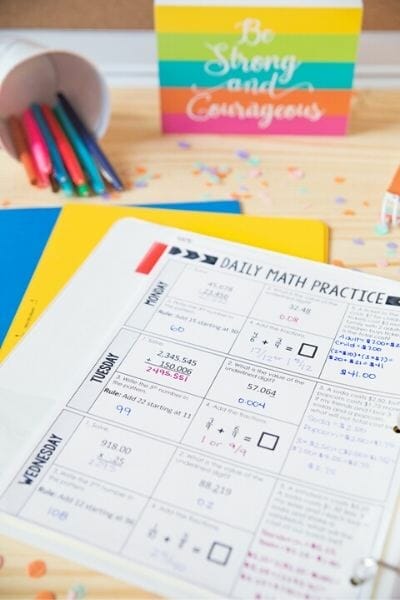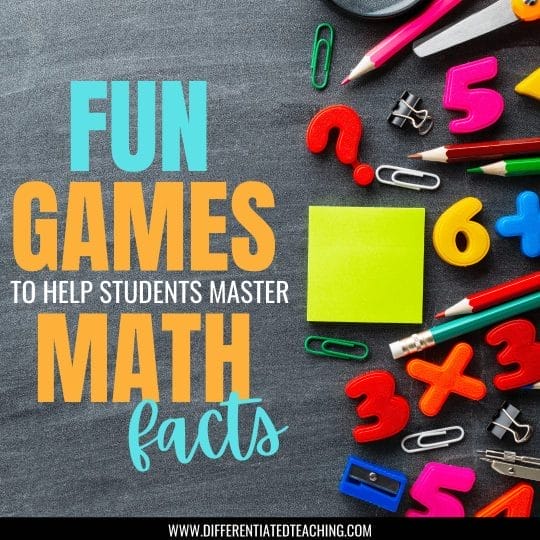How to Use a Math Spiral Review to Increase Achievement
There are many school districts that have mandated spiral review without considering potential issues that can arise. Ineffective implementation of a math spiral can actually cause more issues for learners. However, there is research available to help guide best practice, and using that research I’ve refined a purposeful spiral review that has been really beneficial in helping my students experience higher levels of math achievement in my classroom.
Today I want to share the process I used to create and refine this resource to get the most out of my math spiral review time.

Math Spiral Review in my Classroom: An overview
A math spiral has been an important part of my instructional practices for several years now. Over time, I’ve been able to read and incorporate more research-based best practices to maximize this time in my elementary classroom.
While I make minor adjustments each year in order to support the needs of the students in my classroom. Here are a few things that are non-negotiable.

1. I’ve developed a routine to make the most of the time.
During the first week of school, I teach the kids how to complete the spiral review, and we take several days to practice the process together. I teach my learners that when they arrive in the morning, they should pull their math spiral out of their morning work folder and begin working on the day’s questions.
Once I feel confident that they understand the procedure, we begin completing the math spiral in the morning when students arrive. Students are taught to put it back in their morning work folder when complete, and we grade it during the first five minutes of our math block.
I also make sure the students understand how to request and receive help once they’ve started completing the work independently. They know Monday through Thursday, they are welcome to ask questions, get help from peers, and we can work through a mini-lesson to reteach and refresh the skills.
Friday’s work is considered a quick-check or quiz. The questions from this day are used as a way for me to formatively assess their mastery of the week’s core skills.
2. I focus on being efficient with time to keep students engaged.
It only takes about 8-10 minutes for most students to complete the five questions.
After reading the brain research on attention and the average attention span for students, I decided to keep the five-question format on my spiral review. Of these, four are skill-based and the final question is a word problem. On average, it takes students between 5-10 minutes to answer all five questions.
We spend another 8-10 minutes reviewing the answers and sharing out at the beginning of our math block, making our total time about 20 minutes.
3. I make sure my math spiral review is highly focused.
Each of the five problem types repeats all week. For example, if the first problem deals with fractions, it will be that way the entire week.
Specific skills spiral more regularly. Place value, for example, spirals through approximately every 2 weeks. It takes different forms (decomposing, changing forms, etc.), but it is a skill that causes struggles EVERY. SINGLE. YEAR. so I built it in more often.
I decided to purposefully plan this after a year where there were a few unexpected surprises right around testing time. You know the type where you bring up something the students mastered in September, and you’re met with blank stares.
It also helps prevent the kids from having a a whole year of learning between discussions of essential vocabulary related to those once-a-year topics.
4. I differentiate to meet my struggling students’ specific needs.
If you walked into my class during this time, you might see some kids working using math manipulatives, some with a partner reading the question to them, and some with scratch paper feverishly drawing a sketch to help them solve.
However, I also make adjustments for individual students based on their personal needs. I have a few alternative versions of my morning work. This means my struggling math students or struggling readers still get the opportunity to spiral on skills on their level and exposure to grade-level standards.
I know that sounds like a lot of work.
I’m not going to lie. It WAS a lot of work.
However, I can justify it because it has made an amazing difference for my students.
Instead of spending hours on review before testing, I am able to keep teaching with only a little bit of time spent on test prep because my students have built automaticity with the skills taught earlier in the year. For that reason alone, I definitely recommend putting the time in.

How to get the Daily Math Spiral Review
Of course, I also know that we are all busy, and spending hours upon hours writing a spiral review might not be your idea of a fun Saturday night (sadly, it is mine).
That’s why I want to share mine to save you time.
Try out my Daily Math Spiral FREE for 2 weeks!
It is so important to make sure that anything you use in your classroom is a good fit for your students and teaching style.
For that reason, I’ve created an opportunity to try my Daily Math Spiral Review for free.






